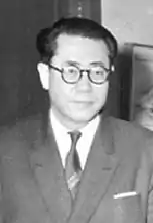1979 South Korean presidential election
Presidential elections were held in South Korea on 6 December 1979 following the assassination of Park Chung Hee on 26 October. The deputies of the National Council for Reunification, who among other things, were responsible for election of president, selected Prime Minister Choi Kyu-hah as the President of the Republic of Korea unopposed; Choi had been acting President since Park's death.[1]
| ||||||||||||||
2,560 Deputies of Reunification Assembly 1,281 votes needed to win | ||||||||||||||
|---|---|---|---|---|---|---|---|---|---|---|---|---|---|---|
| ||||||||||||||
 Votes of the National Council for Reunification
■ – Choi Kyu-hah ■ – Invalid | ||||||||||||||
| ||||||||||||||
President Choi was supposed to serve for the remainder of late President Park's term, which would have ended in 1984. However, a coup d'état took place six days after the elections, which Chun Doo-hwan seizing power. He allowed Choi to remain in power for eight months, before being elected president in August 1980.
Results
In order to be elected, a candidate had to receive the vote of over 50% of the incumbent members of the National Council for Reunification. With 2,560 deputies in office, Choi had to receive at least 1,281 votes to be elected. He received 2,465 votes, 96.29% of the total possible.
| Candidate | Party | Votes | % |
|---|---|---|---|
| Choi Kyu-hah | Independent | 2,465 | 96.29 |
| Invalid/blank votes | 84 | – | |
| Total | 2,549 | 100 | |
| Electorate/turnout | 2,560 | 99.57 | |
Result per region
| Region | Turnout | % | Eligible electors | Vacant seats | Total |
|---|---|---|---|---|---|
| Seoul | 388 | 99.49 | 390 | 1 | 391 |
| Busan | 144 | 99.31 | 145 | 0 | 145 |
| Gyeonggi | 318 | 100 | 318 | 1 | 319 |
| Gangwon | 148 | 98.67 | 150 | 1 | 151 |
| North Chungcheong | 130 | 100 | 130 | 1 | 131 |
| South Chungcheong | 232 | 100 | 232 | 3 | 235 |
| North Jeolla | 200 | 99.01 | 202 | 1 | 203 |
| South Jeolla | 309 | 99.36 | 311 | 1 | 312 |
| North Gyeongsang | 369 | 99.46 | 371 | 8 | 379 |
| South Gyeongsang | 284 | 100 | 284 | 6 | 290 |
| Jeju | 27 | 100 | 27 | 0 | 27 |
| Total | 2,549 | 99.57 | 2,560 | 23 | 2,583 |
References
- Asia Watch Committee (1986). Human Rights in Korea. p. 31.
